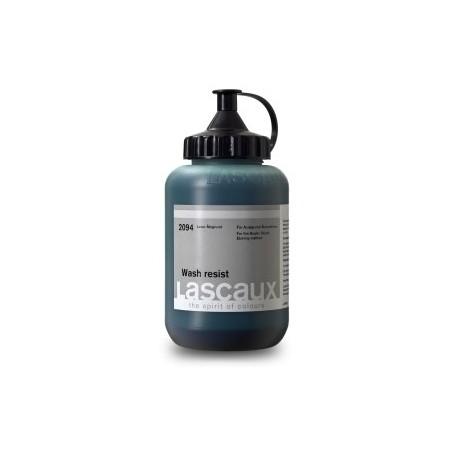REF

Lascaux
REF

Available in 85ml & 500ml bottles
Lascaux Wash resist 2094 has been specially designed as part of the acrylic-resist etching system and should be used in combination with Lascaux Aquatint spray resist. This unique acid resist is painted on etching plates to create washes and tonal effects. They are particularly effective on copper.
Composition
Based on acrylic copolymer.
Lascaux Wash resist has been specially designed as part of the acrylic-resist etching system and should be used in combination with Lascaux Aquatint spray resist. This unique acid resist is painted on etching plates to create washes and tonal effects. They are particularly effective on copper.
Directions
Plates should be prepared, grained, degreased and dried before the Wash resist is applied (follow the detailed information provided in the technical sheet for Lascaux Hard resist).
Painting techniques:
Lay the plate flat on a clean workboard in an area with good light. The resist works due to the ability of the different elements in the solution (in the form of painted marks) to separate before they dry. The mixture therefore will separate in the container and should be shaken vigorously for five minutes to distribute the particles evenly. Squeeze a small amount into a clean china or glass palette and stir regularly during the painting period. The resist has an ink- like consistency and can be painted, poured, spilled or splashed onto the plate surface using a variety of artist’s tools, Chinese and other brushes. The resists may be used at full concentration or diluted with water, either on the plate or in a palette, to create a range of spectacular wash effects. Experiment with different dilutions on test plates to familiarize yourself with painting techniques.
Drying the resist:
The plate can be laid flat to dry naturally or dried with a warm air fan in a horizontal drying cabinet. The drying time will be affected by the quantity of water used during the painting process.
Processing the Wash resist image:
To create a contrast a uniform application of Lascaux Aquatint spray resist should be applied when the Wash resist painting has dried, before etching.
Etching:
The plate can be etched in a variety of mordants such as solutions of ferric chloride (for copper and brass) or copper sulphate mixtures (for steel and zinc). Correct facilities and safety precautions should be used when etching. Plates should initially be flash bitten (etched for a few minutes) to reveal the areas of metal which are etching. If flash biting does not reveal any problems normal biting can commence. A long etch will provide the best results. In some cases a second aquatint can be applied. After etching, plates should be rinsed and deoxidised before removing the resists prior to proofing.
Resist removal:
The resist is water-soluble and can be cleaned from brushes, tools, palettes, plates and surfaces with warm soapy water before it dries. Dried resist can be removed by immersing the plate in a tray or tank of Lascaux Remover for ten minutes. The plate is removed from the tray and the weakened Wash resist and Lascaux Aquatint spray resist are immediately rubbed from the plate surface (the solution should not be allowed to dry) with a brush or non-scratch knitted type plastic cleaning pad pad (gloves should be worn). The plate is then rinsed in warm water and examined for any remaining resist. The process may be repeated until the plate is clean. If other resists are to be applied the plate should be degreased. Dried resist on palettes can be removed by peeling or soaking in hot water. Brushes with deposits of dry resist can be soaked in Remover, washed in soap and then rinsed thoroughly.
Working the plate further:
The surface may be lightly wet-sanded or polished to enhance the contrast and clarity before proofing. The plate may also be worked further using subtractive or additive methods.
More information
This product has been developed in collaboration with the printmakers Robert Adam and Carol Robertson who have been researching and teaching safer printmaking methods since 1990.
Specific References
You might also like
Ultraflex engraver liquid ground